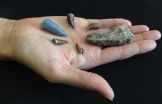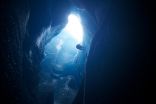(Press-News.org) Droplets are simple spheres of fluid, not normally considered capable of doing anything on their own. But now researchers have made droplets of alcohol move through water. In the future, such moving droplets may deliver medicines, etc.
To be able to move on your own – to be self-moving – is a feature normally seen in living organisms. But also non-living entities can be self-moving, report researchers from University of Southern Denmark and Institute of Chemical Technology in Prague, Czech Republic.
The researchers have made alcohol droplets move in a life-like way, and this could lead to interesting new technology, they say.
"The system itself is very simple but yet it displays sophisticated behavior", explains principal investigator Martin Hanczyc, who was at Center for Fundamental Living Technology (FLINT), University of Southern Denmark, when the research was done.
Martin Hanczyc is now at Centre for Integrative Biology, University of Trento in Italy. The study's first author is Jitka Cejkova, also formerly with University of Southern Denmark, now assistant professor at the Chemical Robotics Laboratory of Professor Frantisek Stepanek at the Institute of Chemical Technology in Prague.
Hanczyc and his colleagues from Prague have shown that small droplets of alcohol in water can move through complex mazes. The droplets can be led to certain targets, and therefore they may be used as a technology to physically move chemistry to a place where it is desired.
"For example, the droplet can act either as a lubricant, targeting an area that needs lubrication. Or the droplet can act as a carrier for chemistry that can find a target destination and release its content, such as flavoring, medicine etc.", Martin Hanczyc explains.
The droplets start to move when they sense salt in their environment.
"Salt is the stimulus that makes them move. They move because the salt gradient provides a different energy landscape. It is like taking a ball that is laying still on a flat surface and then suddenly make the surface hilly. The ball will roll to the lowest accessible point. That is what the droplet is doing. Without a salt gradient every direction in which a droplet might move looks the same (flat). But with a salt gradient coming from one direction the droplet can move energetically downhill into the salt gradient. And stronger salt concentrations will attract the droplet more", says Martin Hanczyc.
The system is sustainable in that the same droplet can migrate towards salts at different positions added sequentially. In addition the droplet can distinguish between salt sources of different concentration. The process can also be controlled by external temperature stimulus, and when the droplet arrives at the source it can physically fuse with it and react with it.
Martin Hanczyc has previously reported that oil droplets display a life-like moving behavior and may be a simple chemical predecessor to biological life.
INFORMATION:
The youtube video shows an alcohol droplet (pink) find its way through a maze, guided by a salt concentration (yellow).
http://www.youtube.com/watch?v=P5uKRqJIeSs
Ref: Dynamics of chemotactic droplets in salt concentration gradients, Jitka Cejkova, Matej Novak, Frantisek Stepanek, and Martin Hanczyc. Langmuir, Sept 12 2014.
Contacts
Jitka Cejkova
Chemical Robotics Laboratory
Institute of Chemical Technology Prague
jitka.cejkova@vscht.cz
Tel. +420220443292
http://www.chobotix.cz
Martin Hanczyc
Principal Investigator
Laboratory for Artificial Biology
Centre for Integrative Biology
University of Trento
martin.hanczyc@unitn.it.
Tel. +39 0461 285343.
Scientists make droplets move on their own
2014-09-29
ELSE PRESS RELEASES FROM THIS DATE:
Avoid skunky beer this Oktoberfest with the help of chemistry
2014-09-29
WASHINGTON, Sept. 29, 2014 — Oktoberfest is here, and that means beer. And there's nothing worse than reaching for a cold one, taking that first sip and realizing your beer's been skunked: chemicals have reacted to form compounds that cause an awful, bitter taste. This week, Reactions explains why beers get skunky, and what you can do to keep your brews from going bad. Learn all about it at http://youtu.be/9i4dHdQzTFg.
INFORMATION:
Subscribe to the series at Reactions YouTube, and follow us on Twitter @ACSreactions to be the first to see our latest videos.
The American ...
Ancient human genome from southern Africa throws light on our origins
2014-09-29
What can DNA from the skeleton of a man who lived 2,330 years ago in the southernmost tip of Africa tell us about ourselves as humans? A great deal when his DNA profile is one of the 'earliest diverged' – oldest in genetic terms – found to-date in a region where modern humans are believed to have originated roughly 200,000 years ago.
The man's maternal DNA, or 'mitochondrial DNA', was sequenced to provide clues to early modern human prehistory and evolution. Mitochondrial DNA provided the first evidence that we all come from Africa, and helps us map a figurative genetic ...
DNA signature found in ice storm babies
2014-09-29
This news release is available in French. Montreal, September 29th, 2014 - The number of days an expectant mother was deprived of electricity during Quebec's Ice Storm (1998) predicts the epigenetic profile of her child, a new study finds.
Scientists from the Douglas Mental Health University Institute and McGill University have detected a distinctive 'signature' in the DNA of children born in the aftermath of the massive Quebec ice storm. Five months after the event, researchers recruited women who had been pregnant during the disaster and assessed their degrees of ...
Who are the men and boys suffering from anorexia?
2014-09-29
A new study by researchers from the University of Montreal reveals the current state of knowledge about anorexia in men and boys. "Most of the knowledge about anorexia pertains to females. However, about 10% of persons affected are males, and we believe this figure is underestimated," says Laurence Corbeil-Serre, lead author of the study. "Our results show that there appear to be similarities between the behavioural symptoms of males and females, but certain particularities can be identified in males, especially related to personality, gender identity, and sexual orientation."
The ...
Researchers show irradiation plus transplantation effective for treating HIV/AIDS
2014-09-29
Yerkes National Primate Research Center researchers are the first to show that an irradiation plus transplantation combination approach in nonhuman primates can be used to treat or even possibly cure HIV/AIDS, and this new model is providing some answers about the "Berlin patient," the only human thought cured of AIDS. The study is published in the September 25 issue of PLOS Pathogens.
Guido Silvestri, MD, division chief of Microbiology and Immunology at the Yerkes Research Center at Emory, and several of his research colleagues performed the first hematopoietic stem ...
Tooth buried in bone shows prehistoric predators tangled across land, sea
2014-09-29
About 210 million years ago when the supercontinent of Pangea was starting to break up and dog-sized dinosaurs were hiding from nearly everything, entirely different kinds of reptiles called phytosaurs and rauisuchids were at the top of the food chain.
It was widely believed the two top predators didn't interact much as the former was king of the water, and the latter ruled the land. But those ideas are changing, thanks largely to the contents of a single bone.
In a paper published online in September in the German journal Naturwissenschaften, Stephanie Drumheller of ...
Simulations reveal an unusual death for ancient stars
2014-09-29
Certain primordial stars—those 55,000 and 56,000 times the mass of our Sun, or solar masses—may have died unusually. In death, these objects—among the Universe's first-generation of stars—would have exploded as supernovae and burned completely, leaving no remnant black hole behind.
Astrophysicists at the University of California, Santa Cruz (UCSC) and the University of Minnesota came to this conclusion after running a number of supercomputer simulations at the Department of Energy's (DOE's) National Energy Research Scientific Computing Center (NERSC) and Minnesota Supercomputing ...
Myriad presents tumor BRACAnalysis CDx study at ESMO
2014-09-29
SALT LAKE CITY, Utah, Sept. 29, 2014 – Myriad Genetics, Inc. (Nasdaq: MYGN) today announced that its Tumor BRACAnalysis CDx™ companion diagnostic test significantly improved the detection of cancer-causing BRCA1/2 mutations by 44 percent in women with ovarian cancer. Data from this new study were presented at the 2014 European Society for Medical Oncology (ESMO) annual meeting in Madrid, Spain.
"Several previous clinical studies have demonstrated that patients with germline or somatic BRCA1/2 mutations respond to certain DNA-damaging medicines such as the platinum ...
Cells from placentas safe for patients with multiple sclerosis
2014-09-29
Patients with Multiple Sclerosis (MS) were able to safely tolerate treatment with cells cultured from human placental tissue, according to a study published today in the journal Multiple Sclerosis and Related Disorders. The study, which is the first of its kind, was conducted by researchers at Mount Sinai, Celgene Cellular Therapeutics subsidiary of Celgene Corporation and collaborators at several other institutions.
While designed to determine safety of the treatment, early signals in the data also suggested that a preparation of cultured cells called PDA-001 may repair ...
Greenland Ice Sheet more vulnerable to climate change than previously thought
2014-09-29
A new model developed by researchers at the University of Cambridge has shown that despite its apparent stability, the massive ice sheet covering most of Greenland is more sensitive to climate change than earlier estimates have suggested, which would accelerate the rising sea levels that threaten coastal communities worldwide.
In addition to assessing the impact of the increasing levels of meltwater created and spilled into the ocean each year as the climate continues to warm, the new model also takes into account the role that the soft, spongy ground beneath the ice ...




